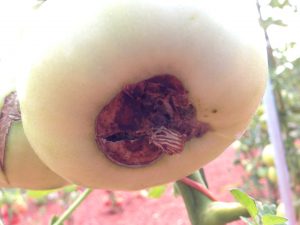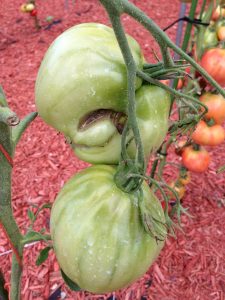Despite the endless list of potential problems, tomatoes continue to be the most popular plant in Midwest vegetable gardens. Many tomato problems are related to environmental factors such as temperature and moisture, rather than insects or disease.
The most common tomato affliction is blossom-end rot, so named for the black, leathery scar that occurs on the blossom end, instead of the stem end, of the fruit. Blossom-end rot most frequently occurs when there are extremes in soil moisture. The uneven levels of moisture lead to a calcium deficiency in the developing fruit. Most soils in the Midwest have plenty of calcium, with the exception of very sandy or highly organic soils. Maintaining an even level of moisture with irrigation and mulching will help prevent blossom-end rot.
Another common problem is blossom drop. Tomatoes are fairly picky about air temperature when it comes to setting fruit. Tomato pollen becomes ineffective when temperatures are below 55 degrees F or above 90 F. Most early-season cultivars are tolerant of cool temperatures but may have problems with hot weather. If tomato flowers are not pollinated, they will drop off the plant. This year was slow to warm up, so early flowers may have dropped off. Now that summer is in full swing, tomatoes should be setting well, though predicted temperatures above 90 F with high humidity may again cause flowers to abort.
The thin skin of many tomatoes may crack open when excessive growth is brought on by rainy periods following a dry spell. To reduce the incidence of fruit cracking, water regularly during dry weather, and apply mulch to conserve soil moisture.
Catfacing is a term given to deformed, misshapen fruit. It occurs when days are cool and cloudy during fruit set. The blossom sticks to the side of the developing fruit, resulting in puckering. The early-set fruit this summer may exhibit this problem.
Sunscald is most common on immature, green fruit exposed to excessive sunlight, particularly during hot weather. It appears as a yellow or white patch on the side of the fruit facing the sun. Often, the tissue blisters and may eventually form a shrunken, grayish-white spot with a papery surface. Sunscald is often a problem on tomatoes that do not have good foliage cover. This can be caused by insect or disease damage, or by plants that sprawl unsupported and open from the weight of the fruit. Supporting tomatoes in a cage helps keep the fruit covered.
Yellow shoulder refers to areas of that stay green or yellow at the top of the fruit, while the rest of the fruit turns red. The tissue is actually damaged well beneath the skin. The cause of yellow shoulder is complex and thought to be related to soil pH being too high, extreme high temperatures, poor foliage cover over the fruits and insufficient potassium (sometimes brought on by too much magnesium). Some varieties seem to be more prone to this than others.
The good news is that these environmental problems are not infectious, meaning they don’t spread to other fruits and plants.



